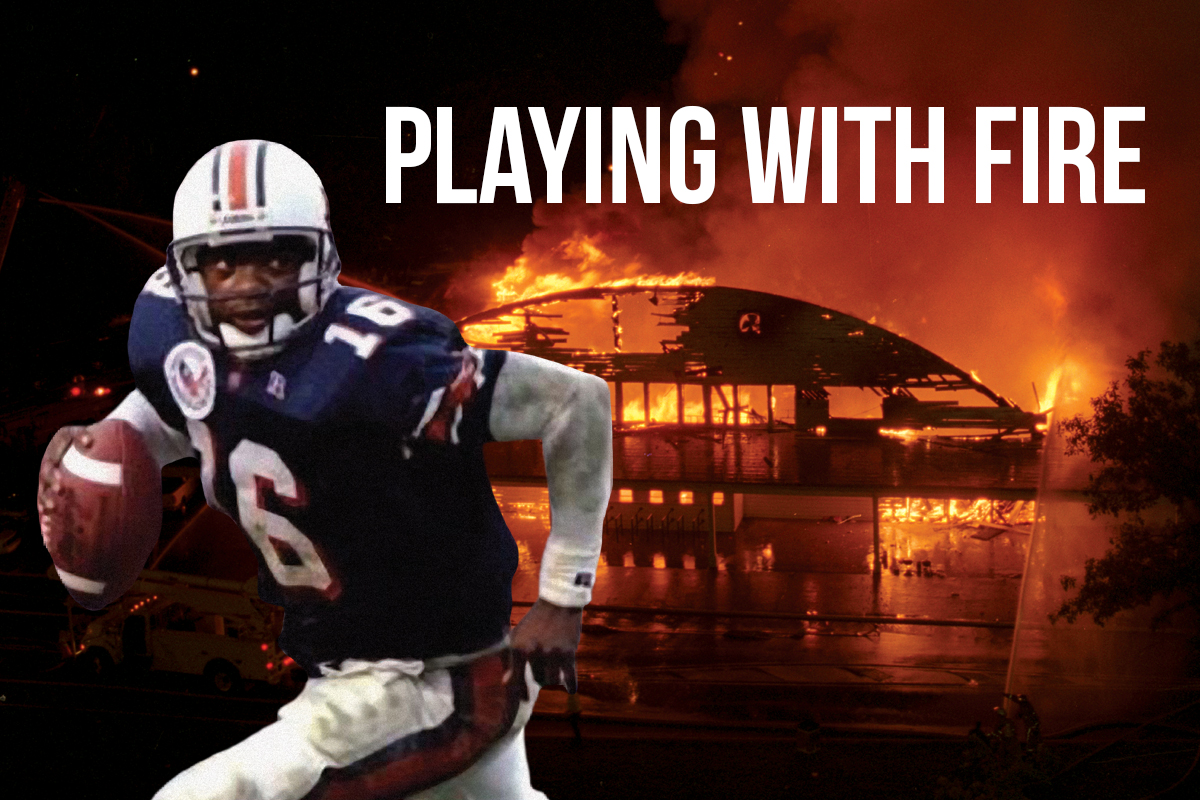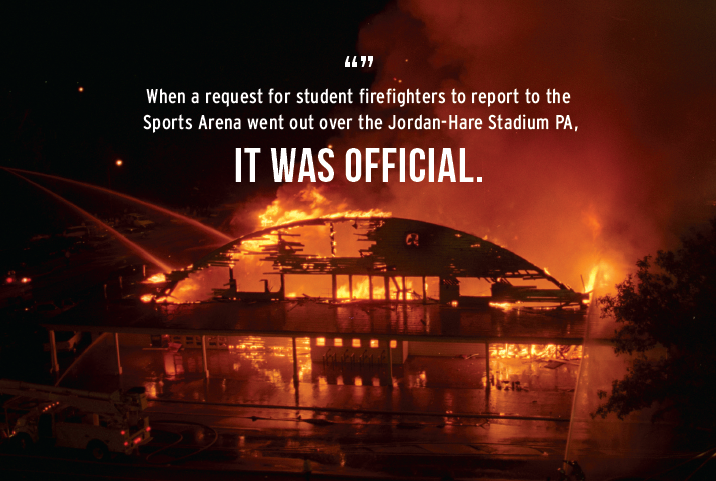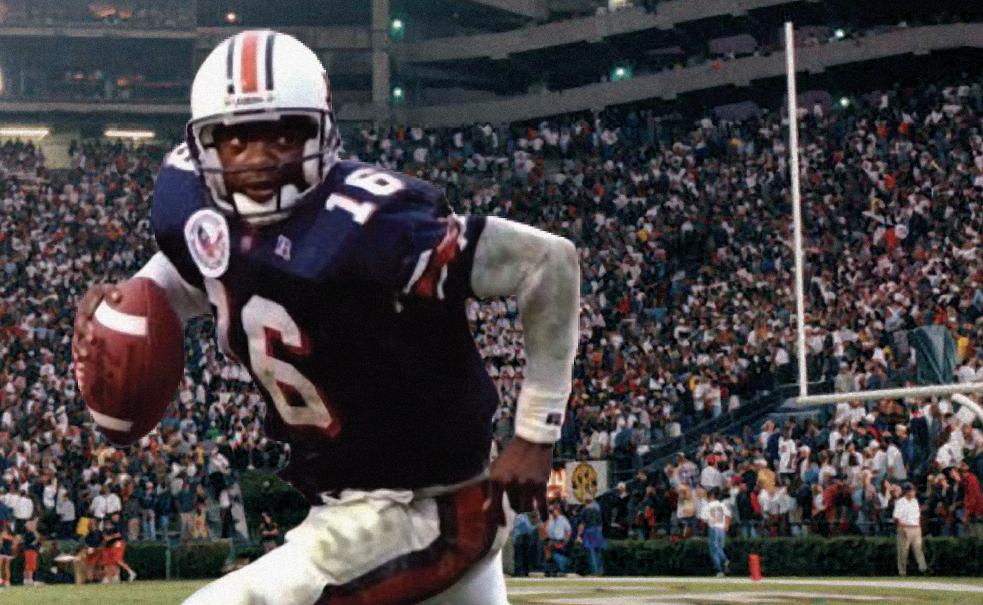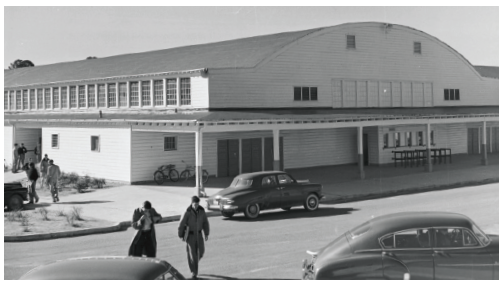Twenty-five years later, Auburn’s “Barn Burner” game is seared in the minds of fans and those who fought the largest fire in campus history.
By Jeremy Henderson ’04

IT WAS HIS NIGHT IN THE WELDING GLOVES. And he missed it. He had to pass the beautiful bird off to one of his Alpha Phi Omega brothers—Kurt something. Twelve of them would take care of Tiger before the Southeastern Raptor Center took over in 2000, and the seniors usually got her for the best games…you know, like the biggest home game of the season.
But no—eight years after 1988’s godforsaken “earthquake game,” the bad guys had apparently brought their damn voodoo with them up from the bayou to brand their bragging rights with yet another natural disaster. He could already hear the headlines: Tigers get torched! SEC hopes go up in smoke! Barn Burner on the Plains!
Good grief… as if lifelong Auburn fan, senior communications major, War Eagle handler and student firefighter Matt Jordan ’97 needed another reason to hate LSU.
The first thing on the right in Station No. 1’s fancy new Public Education Room is the Auburn Bulletin’s front page after the Kopper Kettle explosion. That’s what the old timers used to talk about. But no one currently pulling shifts in town was around in 1978. That’s been true for years.
But there are still a few who actually saw the crazy scenes captured in the first photos on the left with their own eyes. Matt Jordan might even be in one of them. It’s hard to tell. Even if he isn’t, when he sees them, he goes back there. Just for a second. It’s hard not to. It was the biggest fire he’d ever fought. Twenty-five years later, it still is.
Sept. 21, 1996 didn’t just give Matt Jordan the eagle handling student firefighter a wild story to tell. It gave Matt Jordan, the now-deputy fire chief, a defining professional moment to point to.
Jason Brown, ’00 exercise science, and the other Station 2 guys were in the day room fiddling with the antenna. Not that they got ESPN; you had to wiggle things just right just to get WSFA. But you never knew—maybe they’d catch a highlight or something. It was a big game. No. 13 Auburn. No. 21 LSU. Both undefeated. He’d wanted to be there. But such was life for the younger guys in the Auburn University student firefighter program. Most fall Saturdays, you relied on radio.
First came the chatter on the scanner. A lot of it. It was hard to understand. About five seconds after making out the word “stadium,” they heard the tone.
A series of blasts meant a one-station response. This was solid. Solid didn’t mean a car fire on I-85. Solid meant all hands on deck. Solid meant structure fire—Brown’s first as a newly promoted apparatus operator. He threw on his gear and hopped behind the wheel. He looked up. Nope, no time to be nervous. He turned on the lights, flipped on the siren and pointed the engine toward the giant black cloud rising above Auburn University. Jordan didn’t hear the tone. He saw the smoke. Then the flames. Was it the stadium? A nearby building? It really didn’t matter. He knew he was about to switch roles. When a request for student firefighters to report to the Sports Arena went out over the Jordan-Hare Stadium PA, it was official. He handed the eagle off, slipped out of the gloves and started running.
Since 1976, the City of Auburn had operated just two fire stations. In 1997, it added a third. It wasn’t a coincidence. For a story on the expansion, the Auburn Plainsman asked Jordan and freshman Jason Brown to pose by the city’s $220,000 fire truck. That little purchase wasn’t a coincidence, either. “In my mind,” Jordan says, “that night fundamentally changed the fire department’s approach to gamedays. Sept. 11 changed it even more, of course, but it started that night.”

ESPN’s Ron Franklin had to say something.
“This fire has broken behind the stadium…we saw light smoke first, and now we can see flames… Hopefully, it’s not a part of the stadium. Right now, very few people are watching the field. They are very concerned about the situation in the southeastern corner of the stadium…David Housel, the athletics director, is coming toward the booth…it is next door to the stadium….Wow, we’ve had an electric start here but that really has got this crowd with their neck on a spindle. The fire department is there and everyone is safe, so if you’ve got loved ones here, don’t be worried, as Faulk goes over the right tackle, takes it out to the 21, Brumbaugh stops him. No score in our ballgame, 3:39 to play in the first quarter…”

Older grads would point and maybe tell their kids that in 1968, the year before the coliseum opened, they’d watched Auburn beat LSU at that building right there, even with “Pistol” Pete Maravich putting up 49 points. But by 1996, with the exception of the gymnastics team that called it home, most Auburn students simply knew the Sports Arena as the old white wooden building with the rounded roof that kind of looked like a barn. It was some charming piece of yesteryear right by the stadium, a place you could tell friends to meet you to grab their ticket or a beer or a hot dog, a place with an awning under which
tailgaters could apparently keep their coals dry on wet, late- September afternoons.
It was built in 1942 as a recreational facility for the boys of Louisiana’s new Camp Livingston. When Livingston closed after the war, the Federal Works Agency dismantled the thing into sections and relocated all 24,000 hard-pine feet of it next to Auburn Stadium. The basketball team needed a bigger, better home. Alumni Gymnasium had been built in 1916. It was time. The new court was to be christened against Georgia Tech on Jan. 30, 1948. The athletics department expected a capacity crowd of 2,500 and then some. But they wanted the Chesterfields left at home.
Jeff Beard, business manager of the Auburn Athletic Association, asked the Plainsman to notify students not to smoke when attending events in the new Sports Arena. Not only is the smoke a hindrance to the competing athletes, but the building itself is not fireproof, he said.
The Antonio Network
Former Auburn football star Antonio Coleman ’08 returned to his old high school as head coach to turn the football program around. Through a unique group of local alumni, the team has started winning off the field, too.
Sharks, Sea Lions and Spreadsheets
Kristen Rosenberger ’10 keeps the National Aquarium swimming in the right direction.
Photographing the Wonders of the Sea
Phil Smith ’10 found his artistic vision below the waves.
The Antonio Network
Former Auburn football star Antonio Coleman ’08 returned to his old high school as head coach to turn the football program around. Through a unique group of local alumni, the team has started winning off the field, too.
Sharks, Sea Lions and Spreadsheets
Kristen Rosenberger ’10 keeps the National Aquarium swimming in the right direction.
Photographing the Wonders of the Sea
Phil Smith ’10 found his artistic vision below the waves.



